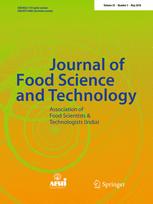Ver ítem
- xmlui.general.dspace_homeCentros e Institutos de InvestigaciónCIA. Centro de Investigaciones de AgroindustriaInstituto de Tecnología de AlimentosArtículos científicosxmlui.ArtifactBrowser.ItemViewer.trail
- Inicio
- Centros e Institutos de Investigación
- CIA. Centro de Investigaciones de Agroindustria
- Instituto de Tecnología de Alimentos
- Artículos científicos
- Ver ítem
Antilisterial efficacy of Lactobacillus bacteriocins and organic acids on frankfurters. Impact on sensory characteristics
Resumen
Dipping solutions containing bacteriocins produced by Lactobacillus curvatus CRL705 and Lactobacillus sakei CRL1862 (Bact705/1862), nisin and organic acids (lactic acid, LA; acetic acid, AA) were tested alone or in combination against Listeria monocytogenes inoculated by immersion on vacuum-packaged frankfurters stored at 10 °C during 36 days. LA/AA solution (2.5% v/v each) reduced pathogen population by 1.50 log10 CFU/ml during storage. Semi-purified
[ver mas...]
Dipping solutions containing bacteriocins produced by Lactobacillus curvatus CRL705 and Lactobacillus sakei CRL1862 (Bact705/1862), nisin and organic acids (lactic acid, LA; acetic acid, AA) were tested alone or in combination against Listeria monocytogenes inoculated by immersion on vacuum-packaged frankfurters stored at 10 °C during 36 days. LA/AA solution (2.5% v/v each) reduced pathogen population by 1.50 log10 CFU/ml during storage. Semi-purified Bact705/1862 prevented L. monocytogenes growth, while nisin was not able to avoid its regrowth after 20 days. The combined addition of Bact705/1862 + LA/AA was the most effective approach for pathogen reduction below detection level from day 6 to final storage. Frankfurters treated with Bact705/1862 + LA/AA compared to fresh-purchased samples did not show significant differences in flavor, juiciness, color intensity and overall preference at 22 days-storage at 5 °C. Meat processors should not only validate the antimicrobial efficacy of combined treatments but also their sensory impact on the product, which is directly related to consumer acceptability.
[Cerrar]

Autor
Castellano, Patricia Haydee;
Peña, Natalia;
Pérez Ibarreche, Mariana;
Carduza, Fernando Jose;
Soteras, Trinidad;
Vignolo, Graciela Margarita;
Fuente
Journal of food science and technology 55 (2) : 689–697. (February 2018)
Fecha
2018-02
ISSN
0022-1155
0975-8402
0975-8402
Formato
pdf
Tipo de documento
artículo
Palabras Claves
Derechos de acceso
Restringido
 Excepto donde se diga explicitamente, este item se publica bajo la siguiente descripción: Creative Commons Attribution-NonCommercial-ShareAlike 2.5 Unported (CC BY-NC-SA 2.5)
Excepto donde se diga explicitamente, este item se publica bajo la siguiente descripción: Creative Commons Attribution-NonCommercial-ShareAlike 2.5 Unported (CC BY-NC-SA 2.5)

